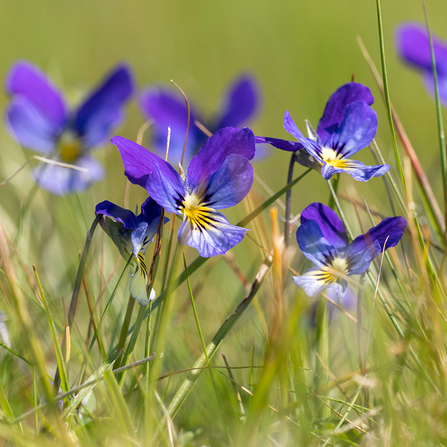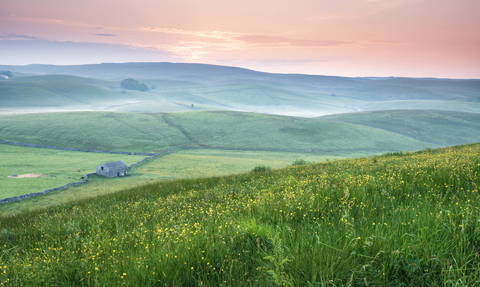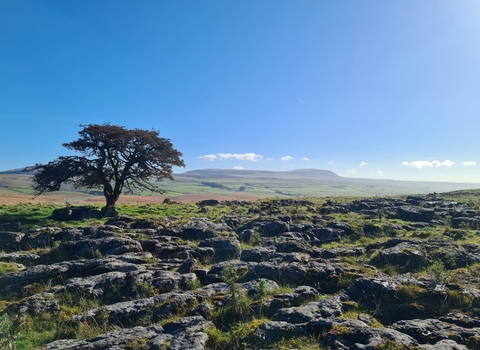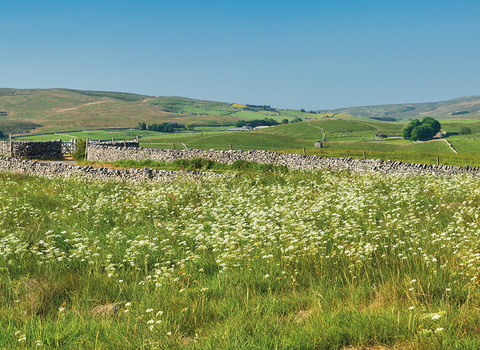
View of Ingleborough from Southerscales - (C) David Berry


Southerscales Nature Reserve
Location
Know before you go
Dogs
Please keep dogs on a short lead at all times and stick to public footpaths.
When to visit
Opening times
Open at all times. We recommend a half day trip for this reserve but if you're looking for a longer outing with more stunning views why not take a longer walk around Wild Ingleborough?Best time to visit
March to JuneAbout the reserve
The spectacular moonscape-like limestone pavement of Southerscales will take your breath away, as will the views on a clear day, revealing the tallest two of Yorkshire’s Three Peaks – Ingleborough and Whernside – and the majestic Ribblehead Viaduct.
Limestone pavement is made up of clints (the blocks) and grykes (the fissures or cracks in between). If you peer into the grykes, you’ll discover a rich, hidden world of plants, such as baneberry, green spleenwort, lesser meadow-rue, wood sorrel and herb Robert. The site is rich in ferns, including rigid buckler and hart’s-tongue.
The spring colours are beyond beautiful, as early purple orchids and primrose come into flower. You might be lucky enough to find the striking emperor moth amongst the flowers, and there are classic upland birds to watch for, including breeding wheatears and meadow pipits. Listen out for singing skylarks and redstarts; ring ouzels sometimes breed in the wooded ghylls nearby.
Contact us
Environmental designation

Mountain Pansies - (C) John Potter
New heights for nature
Ingleborough and its iconic foothills are the last stronghold for rare and threatened species that are found nowhere else in the world.
We must protect, restore and reconnect this iconic landscape today before these species are lost forever.
About
Southerscales nature reserve is located at the foot of Ingleborough and is dominated by a large area of limestone pavement. This is surrounded by calcaereous grassland, blanket bog, heath and acid grassland. These habitats support a diverse range of plant species include rare species such as blue moor grass, frog orchid and birds-eye primrose.
Southerscales is dominated by a carboniferous limestone pavement made up of clints (blocks) and grykes (fissures). The pavement has a rich gryke flora with baneberry, green spleenwort, lesser meadow-rue, wood sorrel and herb Robert. Fourteen species of ferns have been recorded; including rigid buckler fern and hart’s tongue fern.
The remainder of the reserve consists of limestone and acid grassland, and blanket bog. The limestone grassland contains small scabious, early purple orchid and mountain everlasting, while heather grows on the acid grassland. An area of blanket bog holds cross-leaved heath, cranberry, round-leaved sundew and bog asphodel.
In spring the site is full of colour as early purple orchids and primrose come into flower. You may be lucky enough to spot an emperor moth. Wheatear and meadow pipit breed, skylarks often sing overhead, while a deep, croaking call identifies a raven flying over.
In summer wild thyme and fragrant orchid will create areas of pink with the the grassland surrounding the pavement and butterflies such as the dark green fritillary might be recorded. In autumn as the flowers start to wane you could see a black darter or a painted lady.
In winter when the plants have died back the structure of the pavement stands out with the back drop of Ingleborough and Whernside. Ferns such as ridgid buckler fern can still be found in the pavement.
The Trust use cattle to graze the grassland in summer and sheep in the winter to keep a rich variety of plants and grasses on site using the traditional management method of conservation grazing.
History
The fascinating pattern of clints and grykes were formed as the glaciers retreated around 15,000 years ago. There is evidence that indicates that there has been human activity since the Mesolithic period at Southerscales. There are stone piles across Southerscales that are probably Bronze Age burial mounds more than 3500 years old, while to the north of Southerscales Scars there is evidence of an extensive settlement and field system which may date from the Anglo-Saxon period.
Managed by Yorkshire Wildlife Trust since 1982, this site actually forms part of Ingleborough National Nature Reserve, and sits at an altitude of 335 metres. Nearby there are caves and potholes to explore for the more adventurous.
Seasonal highlights
- Spring: Invertebrates - Emperor moth; Birds - Wheatear; Plants - Early purple orchid; Primrose
- Summer: Plants - Wild thyme; Frog orchid; ; Fragrant orchid; Mouse-ear hawkweed; Invertebrates - Dark green fritillary, Birds - Skylark; Redstart
- Autumn: Invertebrates - Painted lady, Plants - Fungi; Birds - Hen harrier; Redwing
- Winter: Plants- Rigid buckler fern; Birds - Merlin
Directions
Public transport
The nearest train station is in Ribblehead.
For up-to-date bus services visit Dales Bus
By car
The nature reserve is off the B6255 Ingleton to Hawes Road. Follow path below the layby and small water company building on the B6255 through the gate. Follow the track towards Ingleborough for three fields to the nature reserve entrance. Another entrance is accessible by parking near the Old Hill Inn and walking south.
Before you go
The Yorkshire Three Peaks route runs through the reserve, which means it can get busy in summer. Take care if you venture onto the limestone pavement – it can get very slippery in wet or frosty weather, and the clints can be unstable.

Ashes Pasture - (C) John Potter


